Antimicrobial: Antibiofilm, Anti-Quorum Sensing and Cytotoxic Activities of Dorystoechas hastata Boiss & Heldr. ex Bentham Essential Oil
Abstract
1. Introduction
2. Results and Discussion
2.1. Phytochemical Evaluation
2.2. Evaluation of the Cytotoxicity Potential
2.3. Evaluation of Antimicrobial Activity
2.4. Evaluation of Antibiofilm Activity
2.5. Evaluation of Anti-Quorum Sensing Activity
3. Materials and Methods
3.1. Plant Materials and Obtaining EOs
3.2. Phytochemical Analysis of EOs
3.3. Evaluation of Cytotoxicity of EO
3.4. Antimicrobial Activity Test
3.5. Antibiofilm Activity Test
3.6. Anti-Quorum Sensing Activity Test
3.7. Statistical Analysis
4. Conclusions
Author Contributions
Funding
Institutional Review Board Statement
Informed Consent Statement
Data Availability Statement
Conflicts of Interest
References
- Valant-Vetschera, K.M.; Roitman, J.N.; Wollenweber, E. Chemodiversity of exudate flavonoids in some members of the Lamiaceae Biochem. Syst. Ecol. 2003, 31, 1279–1289, Erratum in Biochem. Syst. Ecol. 2003, 31, 1465–1467. [Google Scholar] [CrossRef]
- Karagözler, A.A.; Erdağ, B.; Emek, Y.Ç.; Aktaş Uygun, D. Antioxidant activity and proline content of leaf extracts from Dorystoechas hastata. Food Chem. 2008, 111, 400–407. [Google Scholar] [CrossRef]
- Selim, C.; Sever Mutlu, S.; Deniz, I.G. Morphological diversity of Dorystoechas hastata, a relict endemic species, across habitat variability. Pol. J. Environ. Stud. 2021, 30, 2723–2736. [Google Scholar] [CrossRef]
- Gültekin, Z.N.; Kahraman, Ş.; Çetin, H. Larvicidal and ovicidal properties of essential oils derived from Origanum minutiflorum and Salvia dorystoechas against the Aedes aegypti. Comm. J. Biol. 2024, 8, 18–23. [Google Scholar] [CrossRef]
- Erkan, N.; Akgonen, S.; Ovat, S.; Goksel, G.; Ayranci, E. Phenolic compounds profile and antioxidant activity of Dorystoechas hastata L. Boiss et Heldr. Food Res. Int. 2011, 44, 3013–3020. [Google Scholar] [CrossRef]
- Merghni, A.; Noumi, E.; Hadded, O.; Dridi, N.; Panwar, H.; Ceylan, O.; Mastouri, M.; Snoussi, M. Assessment of the antibiofilm and anti-quorum-sensing activities of Eucalyptus globulus essential oil and its main component 1,8-cineole against methicillin-resistant Staphylococcus aureus strains. Microb. Pathog. 2018, 118, 74–80. [Google Scholar] [CrossRef]
- Uslu, Y.; Akbayrak, H.; Ortahisar, B.K.; Barak, T.H. The effect of lavender foot baths on postoperative pain and sleep quality in comparison with foot baths with warm water only—A prospective randomized controlled study. Explore 2024, 20, 385–391. [Google Scholar] [CrossRef]
- Bakkali, F.; Averbeck, S.; Averbeck, D.; Idaomar, M. Biological effects of essential oils–a review. Food Chem. Toxicol. 2008, 46, 446–475. [Google Scholar] [CrossRef]
- Burt, S. Essential oils: Their antibacterial properties and potential applications in foods—A review. Int. J. Food. Microbiol. 2004, 94, 223–253. [Google Scholar] [CrossRef]
- Sharifi, A.; Mohammadzadeh, A.; Zahraei Salehi, T.; Mahmoodi, P. Antibacterial, antibiofilm and antiquorum sensing effects of Thymus daenensis and Satureja hortensis essential oils against Staphylococcus aureus isolates. J. Appl. Microbiol. 2018, 124, 379–388. [Google Scholar] [CrossRef]
- Cáceres, M.; Hidalgo, W.; Stashenko, E.; Torres, R.; Ortiz, C. Essential oils of aromatic plants with antibacterial, anti-biofilm and anti-quorum sensing activities against pathogenic bacteria. Antibiotics 2020, 9, 147. [Google Scholar] [CrossRef]
- Barak, T.H.; Döğenci, İ.; Bardakcı, H. Evaluation of the essential oil samples that are sold as “Eucalyptus oil” on the market in Türkiye in terms of European Pharmacopoeia 10.0 criteria. J. Pharm. Res. 2023, 27, 1463–1473. [Google Scholar] [CrossRef]
- Iriti, M.; Faoro, F. Chemical diversity and defence metabolism: How plants cope with pathogens and ozone pollution. Int. J. Mol. Sci. 2009, 10, 3371–3399. [Google Scholar] [CrossRef]
- Baser, K.H.C.; Öztürk, N. Composition of the essential oil of Dorystoechas hastata, a monotypic endemic from Turkey. J. Essent. Oil Res. 1992, 4, 369–374. [Google Scholar] [CrossRef]
- Kan, A.; Günhan, R.S.; Çelik, S.A. The chemical composition profile of Dorystoechas hastata Boiss. & Heldr. Ex Bentham Cultivated in Turkey. Rec. Nat. Prod. 2015, 9, 135–145. [Google Scholar]
- Ulubelen, A.; Meriçli, A.H.; Meriçli, F. Diterpenes and norditerpenes from the roots of Dorystoechas hastata. Pharmazie 2004, 59, 301–303. [Google Scholar] [CrossRef]
- Özcan, M.M.; Chalchat, J.C.; Figueredo, G.; Bagci, Y.; Dural, H.; Savran, A.; Al-Juhaimi, F.Y.; Özcan, M.M. Chemical composition of the essential oil of the flowers and leaves of Çalba tea (Dorystoechas hastata Boiss & Helder. ex Bentham). J. Essent. Oil Bear. Plants 2016, 19, 782–785. [Google Scholar] [CrossRef]
- Hyldgaard, M.; Mygind, T.; Meyer, R.L. Essential oils in food preservation: Mode of action, synergies, and interactions with food matrix components. Front. Microbiol. 2012, 3, 12. [Google Scholar] [CrossRef]
- Guimarães, A.C.; Meireles, L.M.; Lemos, M.F.; Guimarães, M.C.C.; Endringer, D.C.; Fronza, M.; Scherer, R. Antibacterial activity of terpenes and terpenoids present in essential oils. Molecules 2019, 24, 2471. [Google Scholar] [CrossRef]
- Mahmood, M.A.; Abd, A.H.; Kadhim, E.J. Assessing the cytotoxicity of phenolic and terpene fractions extracted from Iraqi Prunus arabica on AMJ13 and SK-GT-4 human cancer cell lines. F1000Resarch 2023, 12, 433. [Google Scholar] [CrossRef]
- Moghadam, M.E.; Sadeghi, M.; Mansouri-Torshizi, H.; Saidifar, M. High cancer selectivity and improving drug release from mesoporous silica nanoparticles in the presence of human serum albumin in cisplatin, carboplatin, oxaliplatin, and oxali-palladium treatment. Eur. Pharm. J. 2023, 187, 106477. [Google Scholar] [CrossRef]
- Porres-Martínez, M.; González-Burgos, E.; Carretero, M.E.; Gómez-Serranillos, M.P. Major selected monoterpenes α-pinene and 1,8-cineole found in Salvia lavandulifolia (Spanish sage) essential oil as regulators of cellular redox balance. Pharm. Biol. 2015, 53, 921–929. [Google Scholar] [CrossRef]
- Yang, Q.; Wu, J.; Luo, Y.; Huang, N.; Zhen, N.; Zhou, Y.; Sun, F.; Li, Z.; Pan, Q.; Li, Y. (-)-Guaiol regulates RAD51 stability via autophagy to induce cell apoptosis in non-small cell lung cancer. Oncotarget 2016, 7, 62585–62597. [Google Scholar] [CrossRef]
- Zhang, Y.; Wang, Y.; Zhao, Y.; Gu, W.; Zhu, Y.; Wang, S. Novel camphor-based pyrimidine derivatives induced cancer cell death through a ROS-mediated mitochondrial apoptosis pathway. RSC Adv. 2019, 9, 29711–29720. [Google Scholar] [CrossRef]
- Nakamura, H.; Takada, K. Reactive oxygen species in cancer: Current findings and future directions. Cancer Sci. 2021, 112, 3945–3952. [Google Scholar] [CrossRef]
- Khan, M.; Yi, F.; Rasul, A.; Li, T.; Wang, N.; Gao, H.; Gao, R.; Ma, T. Alantolac-tone induces apoptosis in glioblastoma cells via GSH depletion, ROS generation, and mitochondrial dysfunction. IUBMB Life 2012, 64, 783–794. [Google Scholar] [CrossRef]
- Barak, T.H.; Eryilmaz, M.; Karaca, B.; Servi, H.; Kara Ertekin, S.; Dinc, M.; Ustuner, H. Antimicrobial, anti-Biofilm, anti-quorum sensing and cytotoxic activities of Thymbra spicata L. subsp. spicata essential oils. Antibiotics 2025, 14, 181. [Google Scholar] [CrossRef]
- Kalemba, D.; Kunicka, A. Antibacterial and antifungal properties of essential oils. Curr. Med. Chem. 2003, 10, 813–829. [Google Scholar] [CrossRef]
- Rivas da Silva, A.C.; Lopes, P.M.; Barros de Azevedo, M.M.; Costa, D.C.; Alviano, C.S.; Alviano, D.S. Biological activities of α-pinene and β-pinene enantiomers. Molecules 2012, 17, 6305–6316. [Google Scholar] [CrossRef]
- Borges, M.F.D.A.; Lacerda, R.D.S.; Correia, J.P.D.A.; de Melo, T.R.; Ferreira, S.B. Potential antibacterial action of α-pinene. Med. Sci. Forum 2022, 12, 11. [Google Scholar] [CrossRef]
- Bains, A.; Sridhar, K.; Kaushik, R.; Chawla, P.; Sharma, M. Enzyme-assisted polysaccharides extraction from Calocybe indica: Synergistic antibiofilm and oxidative stability of essential oil nanoemulsion. Int. J. Biol. Macromol. 2023, 242, 124843. [Google Scholar] [CrossRef]
- Roshni, P.T.; Rekha, P.D. Essential oils: A potential alternative with promising active ingredients for pharmaceutical formulations in chronic wound management. Inflammopharmacology 2024, 32, 3611–3630. [Google Scholar] [CrossRef]
- Wang, L.; Zhang, K.; Zhang, K.; Zhang, J.; Fu, J.; Li, J.; Wang, G.; Zhengying, Q.; Wang, X.; Li, J. Antibacterial activity of Cinnamomum camphora essential oil on Escherichia coli during planktonic growth and biofilm formation. Front. Microbiol. 2020, 11, 561002. [Google Scholar] [CrossRef]
- Anjaneyulu, B.; Saini, N. A study on camphor derivatives and its applications: A review. Curr. Org. Chem. 2021, 25, 1404–1428. [Google Scholar] [CrossRef]
- Vaara, M. Agents that increase the permeability of the outer membrane. Microbiol. Rev. 1992, 56, 395–411. [Google Scholar] [CrossRef]
- Chouhan, S.; Sharma, K.; Guleria, S. Antimicrobial activity of some essential oils—Present status and future perspectives. Medicines 2017, 4, 58. [Google Scholar] [CrossRef]
- Nazzaro, F.; Fratianni, F.; Coppola, R.; De Feo, V. Essential oils and antifungal activity. Pharmaceuticals 2017, 10, 86. [Google Scholar] [CrossRef]
- Borges, A.; Abreu, A.C.; Dias, C.; Saavedra, M.J.; Borges, F.; Simões, M. New perspectives on the use of phytochemicals as an emergent strategy to control bacterial infections including biofilms. Molecules 2016, 21, 877. [Google Scholar] [CrossRef]
- Kerekes, E.B.; Deák, É.; Takó, M.; Tserennadmid, R.; Petkovits, T.; Vágvölgyi, C.; Krisch, J. Anti-biofilm forming and anti-quorum sensing activity of selected essential oils and their main components on food-related microorganisms. J. Appl. Microbiol. 2013, 115, 933–942. [Google Scholar] [CrossRef]
- Servi, H.; Demir, U.; Servi, E.Y.; Gundogdu, B.; Barak, T.H. Antiproliferative and antibacterial activities of four commercial essential oil samples from Boswellia carteri, B. serrata, and two chemotypes of Canarium luzonicum. J. Essent. Oil Bear. Plants 2023, 26, 79–94. [Google Scholar] [CrossRef]
- Özsoy, E.; Barak, T.H.; Yörük, E.; Servi, H.; Yli-Mattila, T. Chemical composition, antifungal activity, and plant-protective potential of Rosa damascena Mill. essential oil against Fusarium graminearum. Pathogens 2025, 14, 383. [Google Scholar] [CrossRef]
- Üstüner, H.; Barak, T.H.; Servi, H.; Ertekin, S.K.; Sen, A.; Dinç, M.; Özkan, V.K. Anticancer, antidiabetic, and antioxidant activities of endemic Stachys buttleri Mill. and Stachys pinardii Boiss. essential oils. J. Essent. Oil Bear. Plants 2023, 26, 1502–1514. [Google Scholar] [CrossRef]
- Clinical and Laboratory Standards Institute (CLSI). Reference Method for Broth Dilution Antifungal Susceptibility Testing of Yeasts, 4th ed.; CLSI Standard M27: Wayne, PA, USA, 2017. [Google Scholar]
- Clinical and Laboratory Standards Institute (CLSI). Methods for Dilution Antimicrobial Susceptibility Tests for Bacteria That Grow Aerobically, 11th ed.; CLSI Standard M07: Wayne, PA, USA, 2018. [Google Scholar]
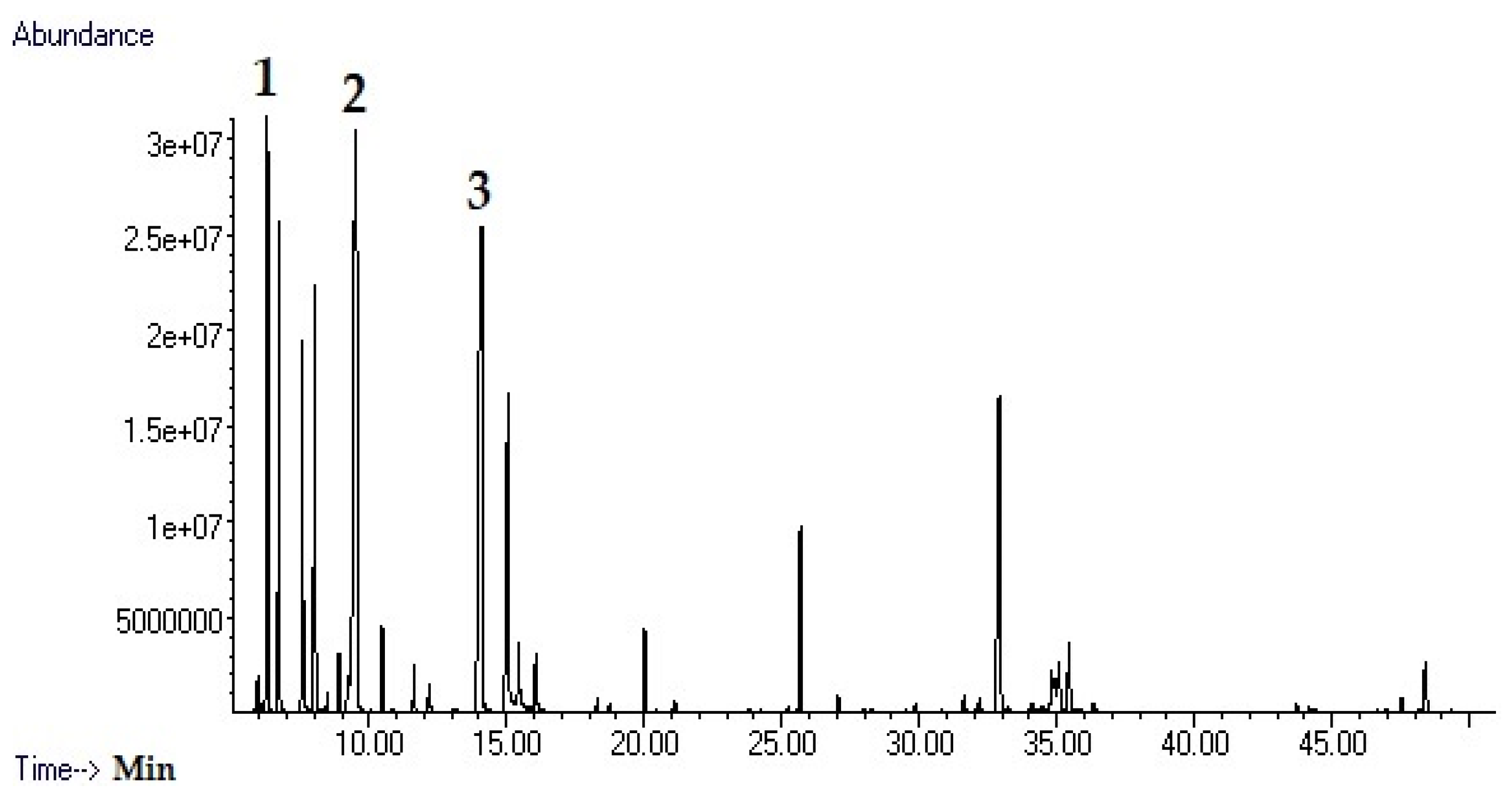
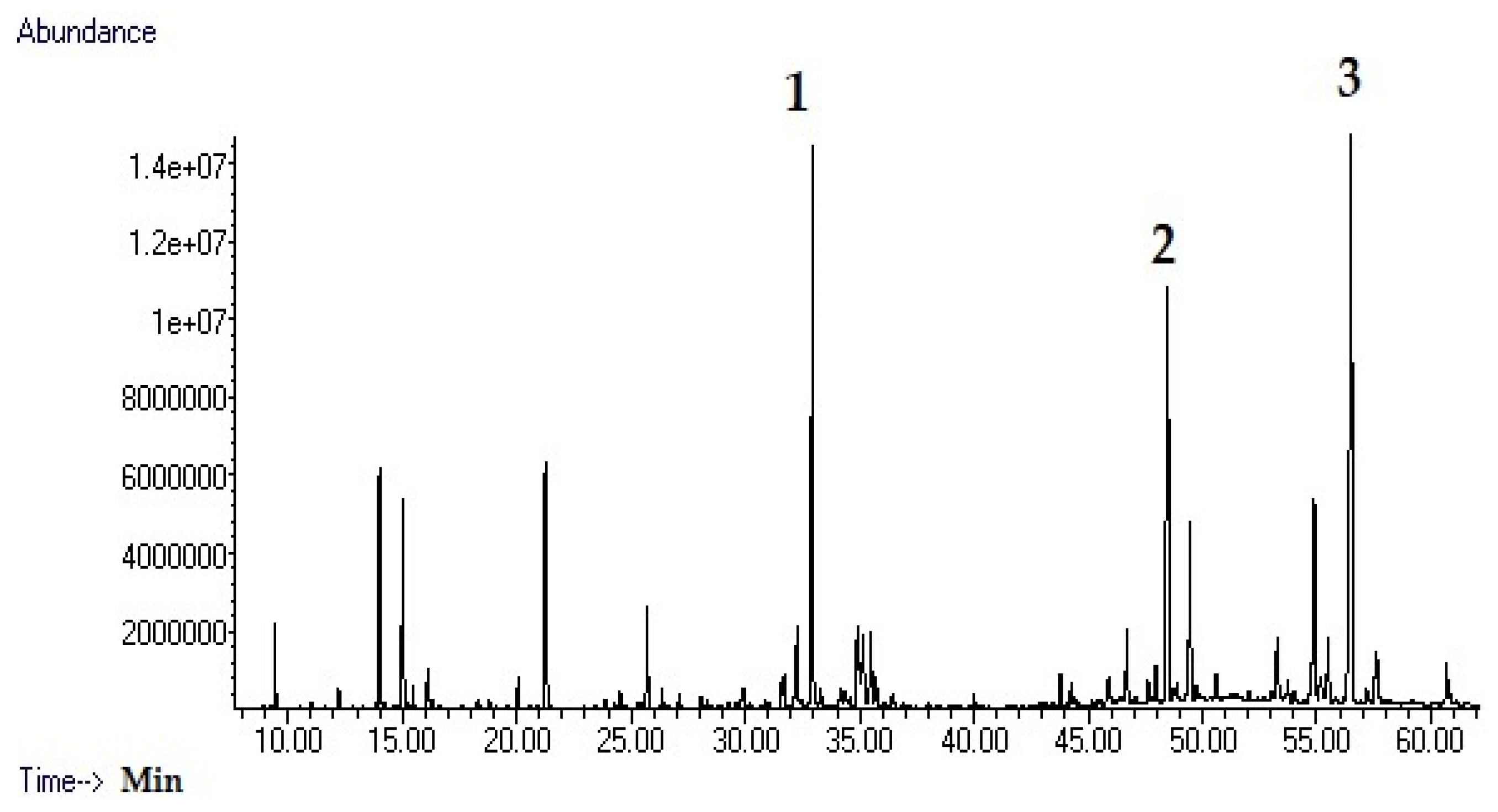
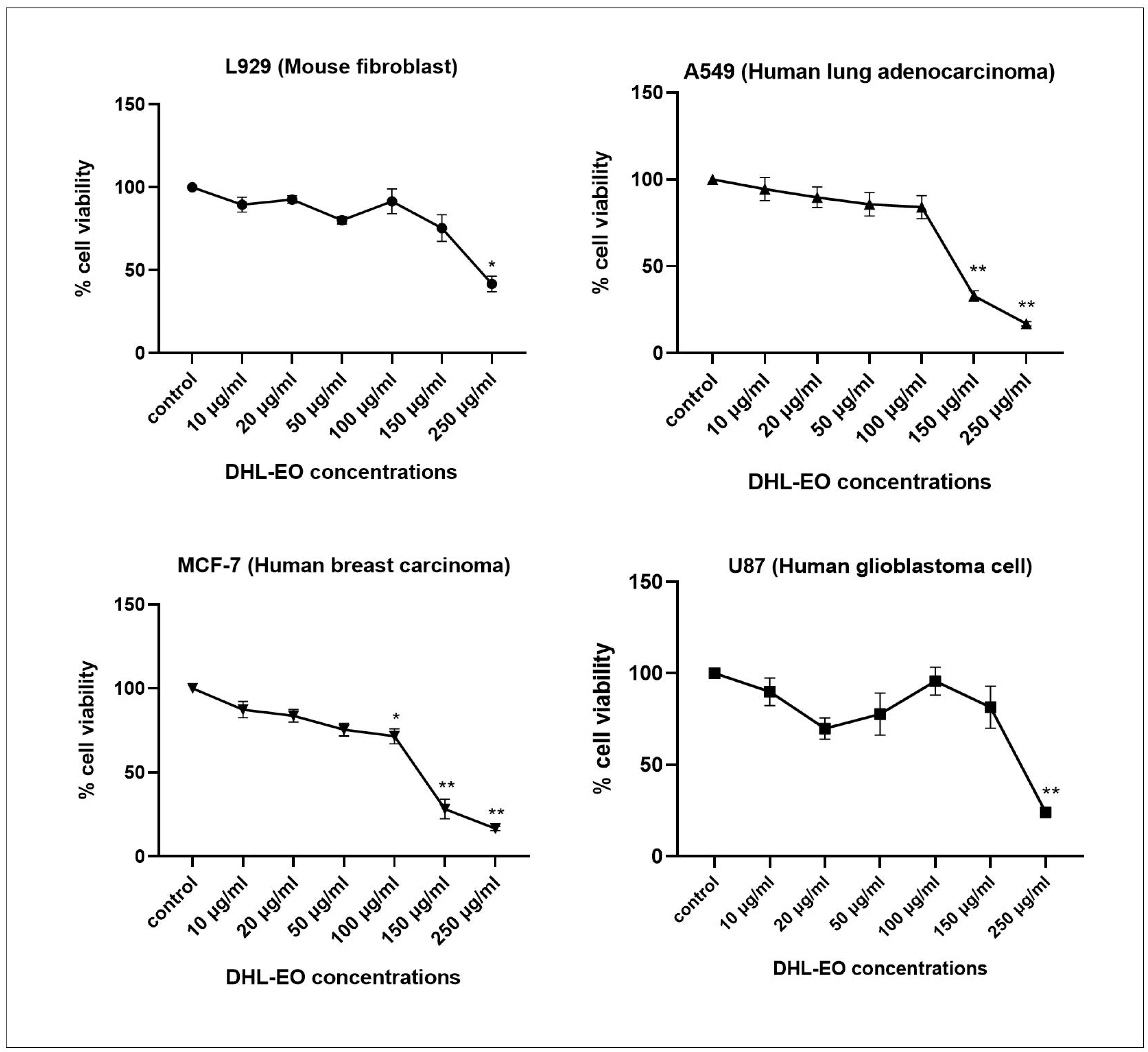
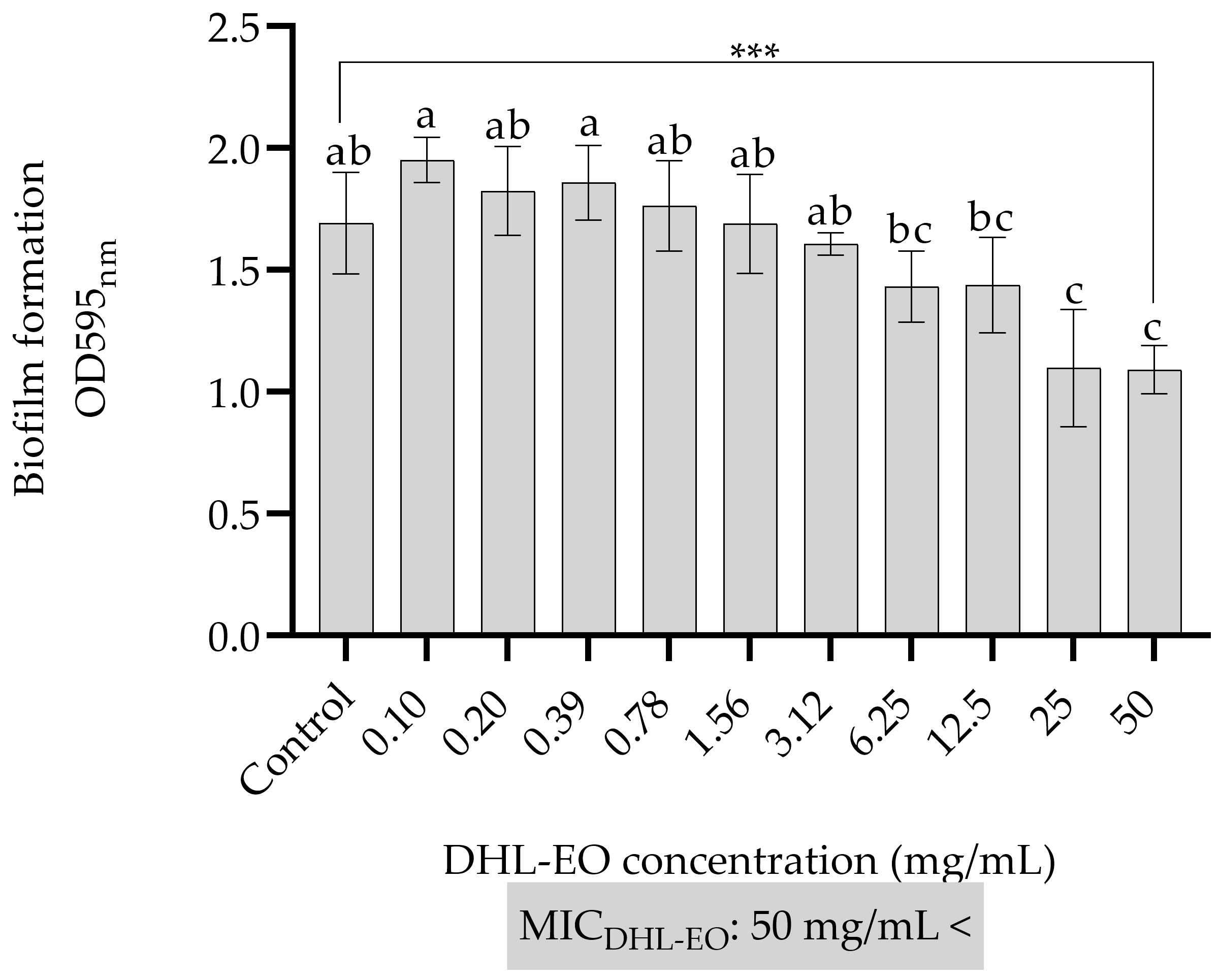
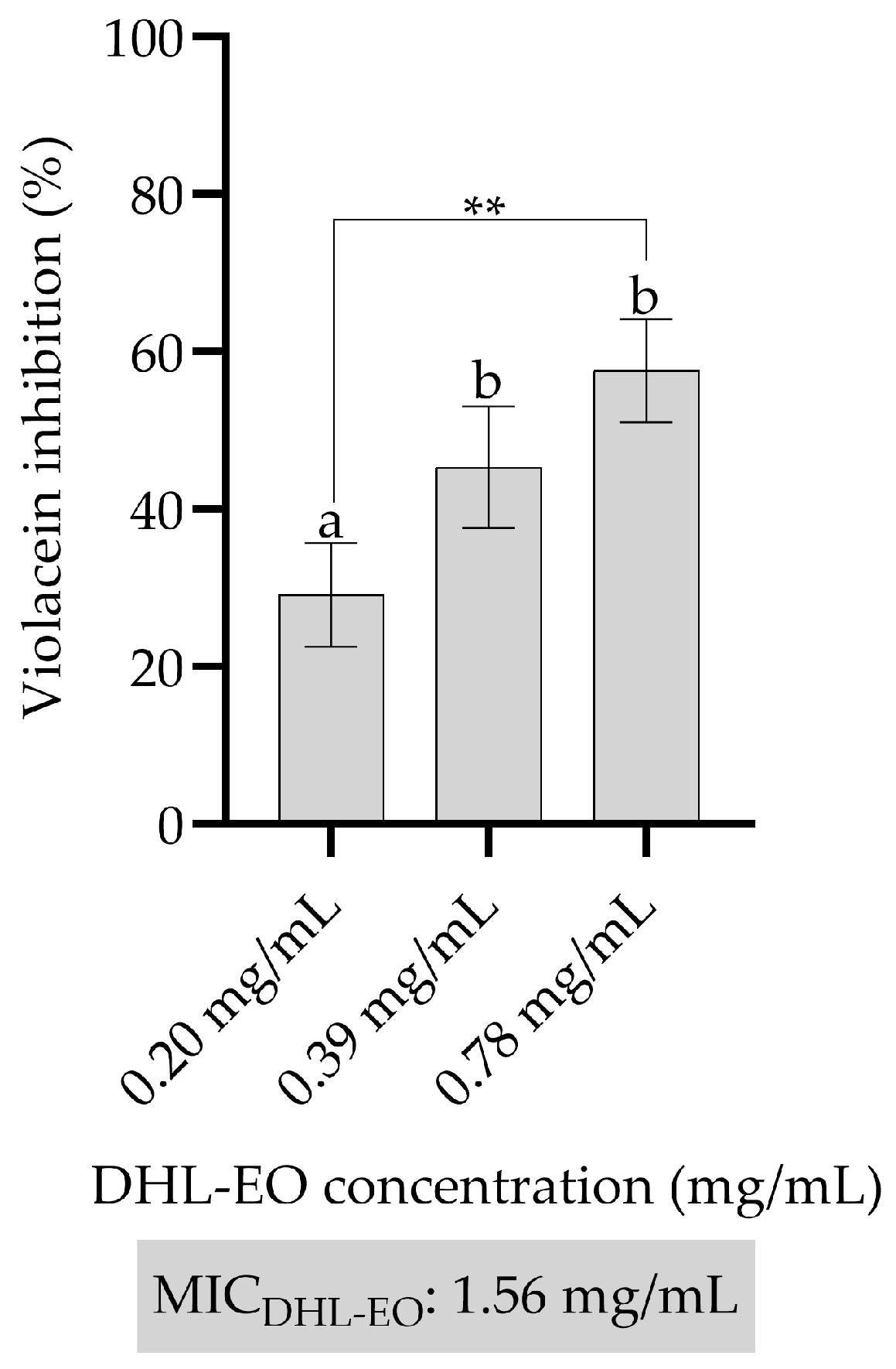
| RT1 | RRI2 | RRI3 | Compounds | DHL-EO (%) | DHR-EO (%) | IM4 |
|---|---|---|---|---|---|---|
| 6.305 | 932 | 939 | α-Pinene | 10.3 | - | RI, MS, RS |
| 6.732 | 947 | 953 | Camphene | 6.9 | - | RI, MS |
| 7.584 | 976 | 980 | β-Pinene | 5.0 | - | RI, MS |
| 8.043 | 991 | 991 | β-Myrcene | 7.4 | - | RI, MS, RS |
| 8.478 | 1005 | 1005 | α-Phellandrene | 0.2 | - | RI, MS |
| 8.911 | 1016 | 1018 | α-Terpinene | 0.8 | - | RI, MS |
| 9.251 | 1025 | 1026 | p-Cymene | 0.8 | - | RI, MS |
| 9.543 | 1033 | 1032 | Eucalyptol | 21.3 | 1.4 | RI, MS |
| 10.478 | 1058 | 1062 | γ-Terpinene | 1.2 | - | RI, MS |
| 11.630 | 1088 | 1083 | α-Terpinolene | 0.7 | - | RI, MS |
| 12.183 | 1102 | 1098 | Linalool | 0.5 | - | RI, MS, RS |
| 13.995 | 1145 | 1143 | Camphor | - | 4.8 | RI, MS, RS |
| 14.093 | 1148 | 1144 | 2-Bornanone | 17.0 | - | RI, MS |
| 15.055 | 1170 | 1169 | endo-Borneol | 8.1 | 4.7 | RI, MS |
| 15.444 | 1180 | 1177 | Terpinen-4-ol | 1.0 | - | RI, MS, RS |
| 16.054 | 1194 | 1189 | α-Terpineol | 1.0 | 0.8 | RI, MS, RS |
| 20.022 | 1286 | 1285 | trans-Bornyl acetate | 1.4 | - | RI, MS, RS |
| 21.261 | 1315 | 1332 | Biosol | - | 7.0 | RI, MS |
| 25.678 | 1421 | 1418 | Caryophyllene | 3.4 | 2.4 | RI, MS, RS |
| 31.628 | 1570 | 1567 | Palustrol | 0.3 | - | RI, MS |
| 32.269 | 1587 | 1583 | Caryophyllene oxide | - | 2.1 | RI, MS, RS |
| 32.895 | 1603 | 1597 | Guaiol | 7.5 | 14.1 | RI, MS |
| 34.819 | 1655 | 1649 | β-Eudesmol | 0.9 | 2.9 | RI, MS |
| 34.917 | 1658 | 1630 | γ-Eudesmol | 0.6 | - | RI, MS |
| 35.063 | 1662 | 1653 | α-Cadinol | 1.3 | - | RI, MS |
| 35.153 | 1664 | 1662 | Neointermedeol | - | 2.4 | RI, MS |
| 35.439 | 1672 | 1666 | Bulnesol | 1.2 | 1.8 | RI, MS |
| 47.971 | 2047 | 2051 | cis-3,14-Clerodadien-13-ol | - | 1.2 | RI, MS |
| 48.389 | 2060 | 2055 | Manool | 1.2 | - | RI, MS |
| 48.475 | 2063 | 2054 | ar-Abietatriene | - | 14.0 | RI, MS |
| 53.276 | 2226 | 2263 | Dehydroabietinal | - | 2.4 | RI, MS |
| 54.885 | 2283 | 2278 | cis-Totarol | - | 7.2 | RI, MS |
| 55.494 | 2305 | 2312 | Abieta-8,11,13-trien-7-one | - | 1.9 | RI, MS |
| 56.509 | 2342 | 2325 | trans-Ferruginol | - | 19.2 | RI, MS |
| 60.689 | 2500 | Salvicanol | - | 1.3 | RI, MS | |
| Total identified | 100.0 | 91.6 |
| Cell Lines | IC50 (μg/mL) | Selectivity Index (SI) * |
|---|---|---|
| A549 (Human lung adenocarcinoma) | 120.4 | 1.89 |
| MCF-7 (Human breast carcinoma) | 110.3 | 2.07 |
| U87 (Human glioblastoma) | 374.8 | 0.6 |
| L929 (Mouse fibroblast (normal) | 228.5 | - |
| Gram-Positive Bacteria | Gram-Negative Bacteria | ||||
|---|---|---|---|---|---|
| S. aureus ATCC 29213 (MSSA) | S. aureus ATCC 43300 (MRSA) | E. faecalis ATCC 29212 | E. coli ATCC 25922 | P. aeruginosa ATCC 27853 | |
| DHL-EO | 12.5 | 12.5 | 50 | 50 | 50 < |
| DMSO (10%) | – | – | – | – | – |
| Ciprofloxacin | <0.00025 | 0.0005 | 0.0625 | <0.00025 | <0.00025 |
| C. parapsilosis RSKK 994 | C. parapsilosis ATCC 22019 | C. glabrata RSKK 4019 | C. krusei RSKK 3016 | C. albicans ATCC 10231 | |
|---|---|---|---|---|---|
| DHL-EO | 0.78 | 3.12 | 50 | 3.12 | 6.25 |
| DMSO (10%) | – | – | – | – | – |
| Amphotericin B | 0.0005 | 0.00025 | 0.0005 | 0.001 | 0.00025 |
Disclaimer/Publisher’s Note: The statements, opinions and data contained in all publications are solely those of the individual author(s) and contributor(s) and not of MDPI and/or the editor(s). MDPI and/or the editor(s) disclaim responsibility for any injury to people or property resulting from any ideas, methods, instructions or products referred to in the content. |
© 2025 by the authors. Licensee MDPI, Basel, Switzerland. This article is an open access article distributed under the terms and conditions of the Creative Commons Attribution (CC BY) license (https://creativecommons.org/licenses/by/4.0/).
Share and Cite
Barak, T.H.; Karaca, B.; Servi, H.; Kara Ertekin, S.; Şentürk, T.B.; Dinc, M.; Ustuner, H.; Eryilmaz, M. Antimicrobial: Antibiofilm, Anti-Quorum Sensing and Cytotoxic Activities of Dorystoechas hastata Boiss & Heldr. ex Bentham Essential Oil. Antibiotics 2025, 14, 1019. https://doi.org/10.3390/antibiotics14101019
Barak TH, Karaca B, Servi H, Kara Ertekin S, Şentürk TB, Dinc M, Ustuner H, Eryilmaz M. Antimicrobial: Antibiofilm, Anti-Quorum Sensing and Cytotoxic Activities of Dorystoechas hastata Boiss & Heldr. ex Bentham Essential Oil. Antibiotics. 2025; 14(10):1019. https://doi.org/10.3390/antibiotics14101019
Chicago/Turabian StyleBarak, Timur Hakan, Basar Karaca, Huseyin Servi, Simge Kara Ertekin, Tuğba Buse Şentürk, Muhittin Dinc, Hatice Ustuner, and Mujde Eryilmaz. 2025. "Antimicrobial: Antibiofilm, Anti-Quorum Sensing and Cytotoxic Activities of Dorystoechas hastata Boiss & Heldr. ex Bentham Essential Oil" Antibiotics 14, no. 10: 1019. https://doi.org/10.3390/antibiotics14101019
APA StyleBarak, T. H., Karaca, B., Servi, H., Kara Ertekin, S., Şentürk, T. B., Dinc, M., Ustuner, H., & Eryilmaz, M. (2025). Antimicrobial: Antibiofilm, Anti-Quorum Sensing and Cytotoxic Activities of Dorystoechas hastata Boiss & Heldr. ex Bentham Essential Oil. Antibiotics, 14(10), 1019. https://doi.org/10.3390/antibiotics14101019










